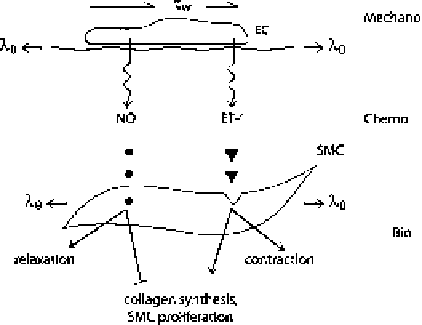Biomedical Engineering Reference
In-Depth Information
Fig. 9.1
Schema of possible mechano-induced production of vasoactive molecules, nitric oxide
(NO) and endothelin-1 (ET-1), by endothelial cells (EC) in response to changes in cyclic wall shear
stress and circumferential wall stretch. Diffusion and consumption of the vasoactive molecules re-
sults in stimulation of smooth muscle cell (SMC) vasoactivity and proliferation as well as synthesis
of extracellular matrix proteins
term). It is also becoming increasingly clear that altered stress affects the produc-
tion, activation, and effectiveness of proteolytic enzymes (e.g., matrix metallopro-
teinases; Humphrey,
2008b
).
Whereas phenomenological equations can be very useful for simulations, as we
learn more and more about the mechanobiology, there is an opportunity—indeed a
responsibility—to move toward more mechanistic modeling. For example, it is now
known that the increase in collagen synthesis by smooth muscle cells in response to
increased mechanical stress/stretch (cf. Fig.
9.1
) is mediated by complex signaling
pathways that involve multiple vasoactive molecules and cytokines. For example, it
appears that increased cyclic stress (as in hypertension due to increased pulse pres-
sure) causes smooth muscle cells to increase their production of angiotensin-II and
possibly to change associated receptor-ligand binding, which in turn stimulates the
production of latent transforming growth factor beta (TGF-
β
) that can be activated
by mechanical stress and ultimately lead to collagen production. Hence, there is an
opportunity to use reaction-diffusion equations (
9.6
) to quantify local changes in
'effector molecules' that in turn influence directly the rates of mass production and
removal (cf. Fig.
9.1
). For example, one could consider mass density production for
collagen (
α
=
c
) such as
m
c
B
1
+···
.
(9.18)
m
c
(τ)
K
TGF
C
TGF
K
ET1
C
ET1
K
NO
C
NO
=
+
+
−
Similarly for smooth muscle (
α
m
), which depends in part on the concentration
of platelet-derived growth factor (PDGF), one could consider
=
m
B
1
+···
.
(9.19)
m
m
(τ)
K
PDGF
C
PDGF
K
ET1
C
ET
K
NO
C
NO
=
+
+
−

